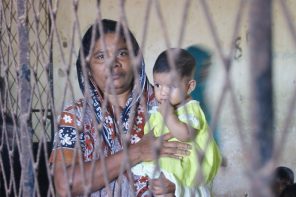Health care and the economy have crowded out most other issues in DC in recent months, but immigration reform advocates are finally getting some breathing room. Last Friday, Janet Napolitano, Homeland Security Secretary, gave a speech outlining a possible immigration reform. And as Arian Campo-Flores writes in a post for Newsweek, pro-immigrant groups are ready to seize the moment. Better organized than they have ever been, immigration reformers have new allies (the National Association of Evangelicals, and Liberty University’s Matthew Staver, to cite two unlikely examples) and they continue to refined their message.
From arguments about morality, or policy, activists have moved to rhetoric of “assimilation,” of supporting immigrants in their wish to become productive citizens.
Indeed, immigration policy debates often hinge on this fundamental question. Will today’s new immigrants assimilate to US society as did the descendants of Italians, Irish, and Polish?
A Country of Two Cultures?
Samuel Huntington wrote that the most serious threat to US identity comes from the large and continued influx of immigrants from Latin America, because these immigrants will be unable to replicate the assimilation ‘success’ stories of immigrants of the past. He considers Mexican immigrants particularly inassimilable due to their continued migration in large scale, proximity of the homeland, and the use of Spanish language in the communities in which they settle.
Huntington was concerned that as their numbers increased, Mexicans would become more committed to their own ethnic group and would have no incentive to participate fully in US society. He noted that rather than downplaying differences, these communities glorified divisions; he feared that continued Mexican immigration could divide the United States into a country of two languages and two cultures.
Welcoming the Stranger
But Huntington’s theories have been challenged by recent research at the intersection of religion and immigration. Three books in particular make a strong case for the positive role of religious community in facilitating new immigrants’ incorporation into the larger society.
In God Needs No Passport: Immigrants and the Changing American Religious Landscape (The New Press, 2007), Peggy Levitt uses the term “religious citizenship” to describe the way that Indian Hindus, Pakistani Muslims, Irish Catholics, and Brazilian Protestant migrants living in Boston carve out alternative sacred landscapes and imagined global religious communities. For these migrants, religion is no longer rooted in a single country; they can remain active members of their origin communities while becoming active participants in the society that receives them.
According to Levitt, this religious citizenship is based on civic activism across borders, which is better attuned to the globalized era in which we live. Thus, contrary to assumptions (based on studies of earlier migration waves) that migrants needed to break with their home communities in order to assimilate in the new society, Levitt demonstrates that the powerful resources that faith communities offer make both, the home communities and new social environments vibrant places in which migrants practice new forms of global civic engagement.
In the book Sacred Assemblies and Civic Engagement: How Religion Matters for America’s Newest Immigrants (Rutgers University Press, 2007), Fred Kniss and Paul D. Numrich examine in depth the link between civic engagement and religious participation, and highlight the central place that religion and congregating religiously still holds among today’s immigrants. In contrast to Levitt’s focus on religious activities across borders, Kniss and Numrich examine several congregations in one area. They look at similarities and differences in moral authority, moral project, and sectarian inclinations among Roman Catholic, Protestant, Orthodox Christian, Jewish, Muslim, Hindu, and Buddhist congregations in Chicago.
Through their comparative analysis, we learn how individuals act politically (in a general sense) and how a particular group works institutionally with other groups. The authors open up the analytical lens to examine immigrants’ civic engagement; thus, rather than focusing on a narrow set of activities, they discuss how religious beliefs shape marriage preferences and educational programs offered to immigrant children, as well as the language used to communicate with other groups. In this way, these authors go back to addressing the classic concern of how religious participation shapes immigrants’ incorporation in the new society. But focusing on new forms of Christianity, as well as on religious practices that did not receive research attention earlier, adds new perspectives and nuance to this longstanding question of immigrant assimilation through civic engagement.
In God’s Heart Has No Borders: How Religious Activists are Working for Immigrant Rights (University of California Press, 2008), Pierrette Hondagneu-Sotelo examines how the actions of religious leaders in the three Abrahamic religions contribute to lessening social suffering and exclusion among recent immigrants who have found an increasingly hostile context of reception in the United States. In contrast to the work of Levitt, or of Kniss and Numrich, Hondagneu-Sotelo does not focus on individual immigrants, but rather on what people of faith do to provide a more humane reception.
The actions of Muslim Americans in the area of civil rights, of Judeo-Christian clergy working for Latino immigrant worker rights, and of ecumenical Christian groups working at the U.S.-Mexican border to direct public attention to immigrant deaths at the border, Hondagneu-Sotelo argues, exemplify how people of faith rely on the “tools” their religions offer to mobilize for immigrants’ rights. Through activist work, individuals of faith seek to contest the lines that separate immigrants and citizens/natives and challenge state policies that exclude immigrants, and in the process create an inclusive, democratic society. Although Hondagneu-Sotelo does not address the question of assimilation directly, she focuses on how the activities of the religious activists seek to create a less hostile environment for immigrants’ incorporation.
These three books offer the rich perspective that comes from examining how immigrants straddle (at least) two sociocultural spaces in an increasingly globalized world, a wider and richer range of new religious practices in places of destination, as well as new forms of exclusion in democratic societies. Instead of dividing the country, today’s immigrants remain deeply connected to their communities of origin while at the same time participating actively in the social and civic lives of their new home. Through new and diverse forms of civic participation, new immigrants are expanding the classic notion of immigrant incorporation.



